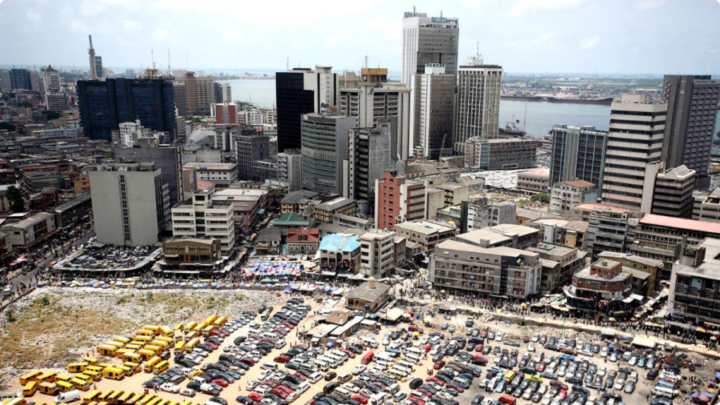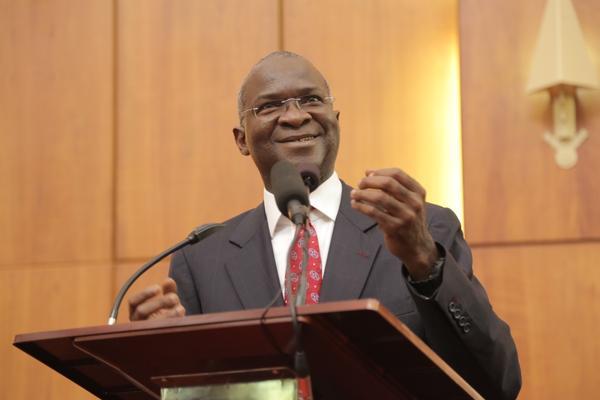It was an expectant morning at the banquet hall of the state house, Abuja, as the economic management team (EMT) engaged representatives of the private sector from all over the country on the economy at the 10th presidential quarterly business forum.
“We didn’t know you have done so much,” said Nike Akande, president of the Lagos Chamber of Commerce and Industry and honorary life Vice-President of the Nigerian Association of Chambers of Commerce, Industry, Mines and Agriculture.
Six minsters had taken turns to brief the leaders of the organised private sector in a manner that told the story of the economy and addressed contemporary issues.
They were budget and national planning minister Udoma Udo Udoma; finance minister Zainab Ahmed; minister of agriculture, Audu Ogbeh; industry, trade and investment minister, Okechuku Enelamah; works, power and housing minister, Babatunde Fashola; and Suleiman Adamu, water resources minister.
Advertisement
With sharp drop in oil revenue from N4076 bn in 2014 to N1439bn in 2016, and low savings to fall back on, the economy was heavily challenged with exchange rate instability, declining reserves, soaring inflation from 8.2 per cent in 2014 to 18.5 per cent in 2016. There were also challenges at the sub-national level.
GDP growth slowed down to 2.11 per cent in the fourth quarter of 2015, and continued to decline through 2016 resulting in the recession.
According to Udoma, the EMT responded with a strategic federal budget in 2016 budget, and the economic recovery and growth plan to stem the slide.
Advertisement
The key fiscal priorities under the ERGP include enhancing revenue generation, collection and monitoring; fiscal consolidation by optimising priority capital and recurrent expenditure; optimising management of both domestic and global fiscal risks; and increased coordination of fiscal, macroeconomic, monetary and trade policies
Expectedly, there was an urgent need to shore up revenue. The measures undertaken included engagement with communities in the Niger Delta to stop shut-in of oil production; transition from joint venture cash calls to a new cost recovery funding mechanism; Executive Order on remittances of GOEs operating surplus; and the introduction of the Voluntary Assets and Income Declaration Scheme (VAIDS) resulting in the number of tax payers rising from 13 to 19 million.
Alongside those were measures to improve public finance efficiency with the implementation of the Treasury Single Account; a whistle blowing policy; establishment of Efficiency Unit to cut costs and block leakages; and the Integrated Payroll Personnel System (IPPIS) implemented across MDAs to enhance efficiency and eliminate unjustified payroll entries, etc.
In line with the ERGP, government increased capital expenditure dramatically in the annual budgets
Advertisement
At the subnational level, a fiscal sustainability plan with the states was adopted.
Acknowledging the role of industrialisation and the importance of the private sector in reviving the economy, the FG stepped up the implementation of the Nigeria Industrial Revolution Plan with the establishment of the Nigeria Industrial Policy and Competitiveness Advisory Council, comprised of the government and private sector representatives at the highest level. It serves as a vehicle for partnering with the private sector on the industrialization agenda and on infrastructure development.
On agriculture sectoral initiatives were undertaken. The Anchor Borrower’s scheme by the Central Bank of Nigeria kicked off resulting in massive cereal production and reduction of imports. Over N120.6 billion has so far been disbursed to more than 800,000 farmers. Eleven fertilizer blending plants with a capacity of 2.1 million metric tons were revitalized, and a Special Presidential Committee on key commodities set up.
To address poverty, the federal government introduced the N500 billion Social Investment Programme. It includes the N-Power, Home Grown School Feeding, and Conditional Cash Transfer, among others meant to assist petty traders, university graduates, NCE holders and other less-privileged Nigerians.
Advertisement
Results
The ministers listed the gains of the recovery process as:
Advertisement
- Growth of Real GDP at 1.81% in Q3 2018, up from 1.50% in Q2 2018 and 1.17% in the corresponding quarter in 2017. The performance was driven by the non-oil sector which grew by 2.32% in Q3 2018, representing the strongest growth in the sector for 12 consecutive quarters since Q4 2015.
- The Services Sector, continued to strengthen in Q3 2018, recording its best performance over 10 quarters, growing by 2.64 per cent, compared to 2.12 per cent in Q2 2018 and a contraction of -2.66 per cent in Q3 2017.
- The drag to GDP growth in 2018, they explained, was largely due to a contraction in the Crude oil and Gas sectors and a slowdown in the agriculture sector, which was affected by temporary production and security challenges in the North East and North Central Zones as well as incidence of flooding.
- Foreign exchange market trends show stability with convergence between the interbank rate (NIFEX) and NAFEX over the past 12 months
- Decline of inflation rate below ERGP target of 12.4 per cent for 2018
- $2.86 billion capital importation in the third quarter of 2018, a 56.7 percent, increase compared to the corresponding period in 2016. They attributed the recent outflow caused by portfolio investors in response to developments in the external environment
- Sustained accretion to external reserves, which recovered from US$28.57bn in May 2015 to US$42.92bn by mid-Dec 2018
- Purchasing Manager’s Index (PMI), a key indicator in assessing the health of the manufacturing sector, in the month of Dec. 2018 stood at 61.1 index points, indicating expansion in the sector for the twenty-first consecutive month
- Under the Social Investment Programme, 1,378,804 loans successfully disbursed in the Enterprise & Empowerment Programme (GEEP), with 1,061,592 loans under the TraderMoni Scheme
- Under the Conditional Cash Transfer scheme, 297,973 people were supported with transfers of ₦5,000 in 217 LGAs across 20 states, while 2,530 community facilitators were trained
- 3 million school children were fed under the Home-Grown School Feeding Programme in 49,000 schools across 24 states; and 96,972 catering staff were engaged; and
- 500,000 graduates benefitted from the N-Power Programme
Udoma described the results as the building of momentum. “Although the Real GDP growth is still low, it’s a movement in the right direction, especially with regard to the non-oil sector performance,” he said. “We are focused on diversification of the economy, in partnership with the private sector.”
Mrs. Ahmed added that target fiscal outcomes will be achieved through accelerating the recovery in GDP growth and stemming inflationary pressures; increasing oil and non-oil revenues to finance priority capital and recurrent expenditures; enhancing fiscal consolidation to rebuild fiscal buffers and increase financial resilience against fiscal shocks; and prioritising investments in critical infrastructure and human capital development.
Advertisement
Fashola
The ministers also detailed out other achievements recorded so far. On power, Fashola said: “The administration has methodically and diligently identified both the quick wins to deliver and the teething but avoidable challenges in the transmission and distribution networks to correct them.
Advertisement
“We have taken bold steps to nipping the challenges in the bud. The notable projects that had dragged for too long are now being completed and commissioned and to increase speed in performance, our administration has introduced the Power Sector Recovery Programme through which funds are being injected into the sector and new strategies evolved to strengthen existing policies in order to achieve our objective of incremental, stable and uninterruptable Power supply.
“Also, in order to have a robust Nigerian Electricity Supply Industry (NESI) and by also exporting electricity to neighbouring African countries, the Discos have been mandated to meter all their customers. Attainment of this feat will make NESI a key player in the West African Power Pool (WAPP).”
Among the projects expected to increase power supply soon from the current 7,000MW are the 40 MW Kashimbilla Power in Taraba And Benue;700mw Zungeru Hydropower Plant and the 215MW Kaduna Power Plant, 2x60mva Substation & 2×1.5mltrs Ago Tanks and the Afam III Fast Power.
Enelamah
The reforms his ministry is leading include improvement in the ease of doing business targeted at achieving a sub-100 World Bank ranking this year; and the establishment of Nigerian Industrial Policy & Competitiveness Council, which aims to increase the contribution of the manufacturing sector to GDP by 250 per cent over a five-year period, and establish Nigeria as the manufacturing hub for West Africa, by implementing initiatives aimed at accelerating industrialization by leveraging private sector expertise and capital; as well as reforms of the automotive sector towards making the country the automotive hub in West Africa; and the building of special economic zones.
He said: “In accordance with the economic recovery & growth lan, which identifies the development of special economic zones as a major strategic tool to accelerate the implementation of the Nigeria Industrial Revolution Plan, Project Made in Nigeria for Exports (MINE) was envisioned by the Ministry and the Nigeria Export Processing Zone Authority to develop SEZs to world class standards and position Nigeria as the pre-eminent manufacturing hub in sub-Saharan Africa and become a major exporter of made-in-Nigeria goods and services regionally and globally.”
Among other objectives, the project seeks to aid structural transformation of the Nigerian economy by increasing the manufacturing sector’s contribution to GDP to 20 per cent by 2025; contribute to sustainable inclusive growth by creating 1.5 million new direct manufacturing jobs in the initial phase of Project MINE; and increase and diversify foreign exchange earnings to at least US$30bn annually by 2025, by increasing manufacturing sector exports.
Other reforms include the creation of the Nigerian Office for Trade Negotiation; improved access to financing for Medium and Small- Scale Enterprises and the delivery of technology-enabled solutions to ease business for MSMEs; as well as the mordinisation of intellectual property Registries (Commercial Law Department Reforms)
He said between January 2015 and October 2018, the Bank of Industry disbursed a total of N487.5 billion to 3,334 large, medium and small enterprises.
Adamu
He disclosed that his ministry inherited 116 major on-going and abandoned projects on assumption of office in 2015: They included 38 projects on irrigation and drainage, 27 dams and 37.
He said with the deployment of resources towards completing and commissioning all the high and medium priority projects 11 projects have been completed and commissioned, while six are ready for commissioning.
“We also plan to complete many more water supply, dam and irrigation projects including 7 water supply projects, and 13 dams and irrigation projects between now and 2020.”’
Private sector participants who spoke at the interactive session expressed appreciation for the information shared and reminded the EMT of lingering problems such as multiple taxation.
Yemi Dipeolu, special adviser to the president for economic matters in the office of the Vice-President, who closed the session with a vote of thanks described it as engaging and commended members of the organised private sector for their presence and consistency.
“We continue to take your views and advice seriously,” he assured them on behalf of the EMT, headed by Vice-President Yemi Osinbajo.
Add a comment







